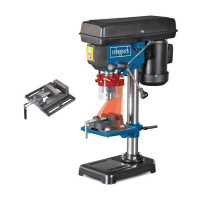www.scheppach.com service@scheppach.com +(49)-08223-4002-99 +(49)-08223-4002-58 www.scheppach.com service@scheppach.com +(49)-08223-4002-99 +(49)-08223-4002-58
GB І 25
Important! Do not leave the chuck key in the
clamp hole.
Doing so will cause the chuck key to be catapulted
out, which could cause injury.
Depth scale method, Fig. 6
Note: for this method, with the spindle in its upper po-
sition the tip of the drill bit must be just slightly above
the top of the workpiece.
1 Switch off the machine, lower the drill so far until
the indicator points at the desired drilling depth of
the depth scale.
2 Turn the lower nut (J2) downwards until it reaches
the lower stop (I).
3 Lock the lower nut (J1) against the upper nut.
4 The chuck and the drill bit will now be stopped
after traveling downward the distance selected on
the depth scale.
Clamping the workpiece (Fig.13+14)
As a general rule, use a machine vice or another suit-
able clamping device to lock a workpiece into posi-
tion.
Never hold the workpiece in place with your hand!
When drilling, the workpiece should be able to travel
on the drill table (3) for self-centering purposes. En-
sure that the workpiece cannot rotate. This is best
achieved by placing the workpiece/machine vice on
a sturdy block.
Important. Sheetmetal parts must be clamped in to
prevent them from being torn up. Properly set the
height and angle of the drill table for each workpiece.
There must be enough distance between the upper
edge of the workpiece and tip of the drill bit.
Positioning table and workpiece, Fig. 14
Always place a piece of back up material (‘wood, ply-
wood...) on the table undemeath the workpiece. This
wiII prevent splitering or making a heavy burr on the
underside of the workpieces as the drill bit breaks
through. To keep the back up material from spinning
out of control it must contact the left side of the col-
umn as illustrated.
Warning:
To prevent the work piece or the backup material
from being torn from your hand while drilling, position
them to the left side of the column. If the work piece
or the backup material are not long enough to reach
the column, clamp them to the table. Failure to do
this could result in personal injury.
Note: For small pieces that cannot be clamped to the
table, use a drill press vise.
The vice must be clamp or bolt to the table to avoid
injury from spinning work and vise or tool breakage.
Using the laser (Fig.15+16)
Replacing the battery: Switch off the laser. Remove
the battery compartment cover (13.1). Remove the
batteries and replace with new batteries .
Adjusting table height., Fig. 11
1 Loosen the table support lock handle (E).
2 Adjust the table (3) to the desired height.
3 Re-tighten the table locking (E).
Note: it is better to lock the table to the column in a
position so that the tip of the drill bit is just slightly
above the top of the workpiece
Choosing speed and tensioning belt, Fig. 12
Note! Pull power plug!
1 You can set different spindle speeds on your pillar
drilling machine:
2 WITH THE SWITCH „OFF“, open pulley cover.
3 Loosen the drive belt on the right side of the ma-
chine head by unfastening the locking nuts (12) on
both sides. Pull the right side of the motor in the
direction of the spindle to loosen the v-belt. Tighten
the wing screws again.
4 Attach the v-belt to the corresponding belt pulleys.
5 Loosen the wing screws and push the right side
of the motor backwards to clamp the v-belt again.
6 Tighten belt tension lock knob. Belt should deect
approximately 13 mm –1/2“ -by thumb pressure at
mid-point of belt between pulleys.
7 Close pulley cover .
8 If belt slips while drilling readjust belt tension.
Tip: Safety switch
If you want to adjust speed you have to open the
pulley cover. The device switches off immediately to
avoid the risk of injuries.
Removing the chuck
Open jaws of chuck as wide as they go by turn-
ing chuck sleeve anticlockwise (when viewed from
above).
Carefully tap chuck with mallet in one hand while
holding chuck in other hand to prevent dropping it
when released from spindle nose.
Fitting tools to the drill chuck
Make sure that the power plug is removed from the
socket-outlet before changing tools.
Only cylindrical tools with the stipulated maximum
shaft diameter may be clamped in the drill chuck (5).
Only use a tool that is sharp and free of defects. Do
not use tools whose shaft is damaged or which are
deformed or awed in any other way.
Use only accessories and attachments that are spec-
ied in the operating instructions or have been ap-
proved by the manufacturer.
Using the drill chuck
Your drill is equipped with a gear-toothed drill chuck
(5). In order to insert a drill bit (7), ip up the chip
guard (5), insert the drill bit, then tighten down the drill
chuck using the supplied chuck key (D).
Pull out the chuck key (D).
Ensure that the clamped tool is rmly seated.

